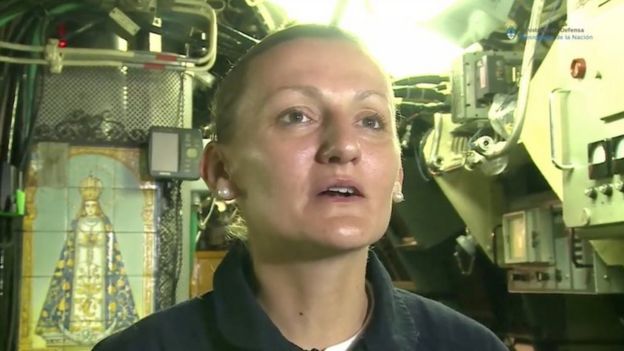Forty-four people are on board the ARA San Juan, which vanished after it reported an electric breakdown.
A navy spokesman, Enrique Balbi, said a massive search operation would continue until the vessel was located.
Better weather conditions on Tuesday, after days of rough sea, have given new hope to relatives of the missing crew.
But Mr Balbi cautioned: "We are considering all possibilities and obviously the most critical situation would be the fact that we are on the sixth day of oxygen."
The search effort has now been narrowed down to an area of 20km by 20km (12 miles), he added.

On Monday, navy officials said that noises picked up by two search vessels did not come from the sub, the second false alarm to hit the search.
What happened to the sub?
The ARA San Juan was returning from a routine mission to Ushuaia, near the southern-most tip of South America, when it reported an "electrical breakdown".
According to naval commander Gabriel Galeazzi, the submarine surfaced and reported the breakdown, which Capt Galeazzi described as a "short circuit" in the sub's batteries.
The sub was ordered to cut its mission short and return to the naval base in Mar del Plata immediately.
According to navy spokesman Enrique Balbi, the captain of the ARA San Juan contacted the naval base once more after reporting the problem.
In the message, he reportedly said that the problem had been adequately fixed and that the sub would submerge and proceed towards Mar del Plata naval base.
The last contact was made at 07:30 local time (10:30 GMT) on Wednesday 15 November. It is not known what happened to the sub after that contact.
Read: What happens when a submarine vanishes
How was the alarm raised?
Argentine navy protocol stipulates that in peace time, submarines make contact twice a day with the base.
When the submarine failed to call in, the Argentine navy began its search for the vessel.
Navy commander Carlos Zavalla at that point spoke only of a "failure to communicate" and urged relatives of the crew to remain calm.
There was no mention by navy officials of the vessel having any problems at the time and rumours of a fire on board were dismissed by the navy's spokesman, Enrique Balbi.
When did news of the breakdown emerge?
On Sunday, relatives of some of the crew said that they had been told in messages sent before contact with the submarine was lost, that there was a problem with the sub's batteries.
On Monday, naval commander Gabriel Galeazzi confirmed the sub's captain had reported a breakdown on Wednesday describing it as a "short-circuit" in the sub's battery system.
Capt Galeazzi said that mechanical problems were not uncommon and rarely posed a risk. "A warship has a lot of backup systems, to allow it to move from one to another when there is a breakdown," he said.
He also said that the sub had not sent a distress signal to the navy base.
Who is on board?
There are 44 crew on board the submarine, which is under the command of Pedro Martín Fernández.
Forty-three of the crew are men but there is also one woman, Eliana María Krawczyk. The 35-year-old is the first female officer in Argentina to serve on a submarine.
Nicknamed "the queen of the sea" by her father she comes from Oberá, a city in northern Argentina.
Despite having been born and raised far inland, her relatives say that "she was born to be a submariner", citing her "will of steel" and a passion for her job.
The rest of the crew is made up of submariners of varying ages and experience.
The sub's engineer, Hernán Rodríguez, has been on the ARA San Juan for 11 years, local media reported.
How is the search going?
Submarines are built to be difficult to find and the search has been further hindered by bad weather.
The Argentine Navy tweeted a video showing the rough conditions at sea.
Waves of up to six metres in height (19.6ft) have made it difficult for search vessels and planes to spot anything on the sea's surface.
Brazil, Chile, Colombia, France, Germany, Peru, South Africa, Uruguay and the UK have all sent either ships or planes to help with the search.
The US Navy has deployed two underwater vehicles which use sonar to create images of the sea floor.
A Nasa research aircraft has also flown over the search area but failed to spot anything.
Despite the failure to find any trace of the sub, the father of one of the crew said relatives remained optimistic.
"In general there's a positive outlook, with the hope that there can be some way of finding them," Jorge Villareal said.
[BBC SOURCES]









0 comments:
Post a Comment